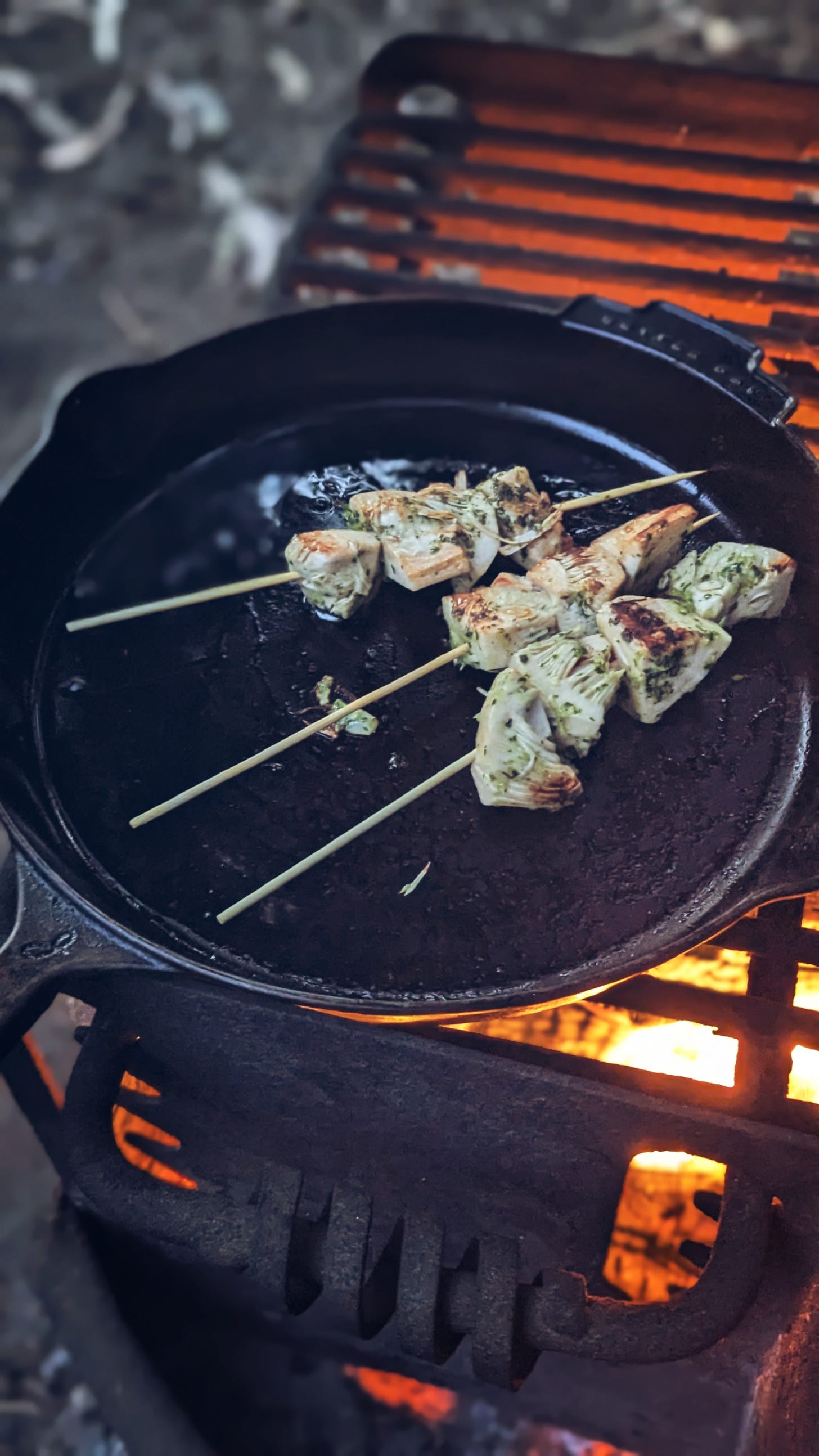Hi friends! This week I tried a vegan version of Kelly Field's sticky buns from The Good Book of Southern Baking (also published on Food52). I have been eager to try everything in this cookbook, although in my opinion, some recipes require fiddling to make them workable at home. In addition to using my usual Brod & Taylor vegan croissant dough, I reduced this recipe for our household size and desired budget. (Fields’ recipe calls for almost 11 sticks of butter per half sheet pan—this impressed me enough that I used it for my word problem homework in math class. This recipe comes in at 3.5 sticks butter in an 8” square cake pan. Still a healthy amount of butter, but not my household's entire food budget.)
I was going to also say that I reduced it due to equipment size—our apartment’s largest flat surface is our 30” table, and Fields' dough rolls out to 32”—but I just read in Melissa Weller’s A Good Bake that you can let the side you aren't rolling hang off the counter! (I wouldn't have assumed this to be true, with all the vagaries of dough, but since Weller says it, I trust that it is one of many methods.) I love these moments where someone says “just tilt the pan,” or “let the dough hang off the counter,” and my world shifts. Our counter space is rather nonexistent, and I would need a stool for leverage—but I could definitely wrap our 30” dining table in plastic wrap as we do the work tables at Laney (compostable at home).
This is all a note for future bakes, as the Brod & Taylor dough mercifully only requires rolling to 18”. I'm very excited to try Weller's croissant dough soon, though. The directions seem to be well thought out, it appears veganizable (no eggs), and uses both sourdough and yeast—all things I have been looking for. I’m rehydrating my most recent starter ordered from
as we speak. :)The Brod & Taylor croissant dough recipe is great as-is, so I'm linking to it rather than changing anything. I have included recipes for sticky topping and cinnamon sugar filling below. Fields' recipe used pastry cream, and I tested with a vegan one—it was delicious, but not worth the fuss in my opinion, so I called for melted vegan butter here.
cane syrup sticky buns
Prepare your Brod & Taylor vegan croissant dough (follow their directions through “third and final fold”).
Prep an 8” square cake pan with your preferred method. (I used a King Arthur metal pan with their standard silicone coating, sprayed with an olive oil spray with no additional ingredients. I am pretty sure from the other hospitality background that lubricating silicone with silicone will degrade it, so avoid dimethyl silicone!—and lecithin in sprays also damages nonstick.)
Make the cinnamon sugar: combine all filling ingredients except butter. Melt butter and set aside.
Roll dough to an 8 x 18” rectangle. (If you're a couple inches short, as I was this time, it’s not the end of the world.)
Spread melted butter on dough, then sprinkle with cinnamon sugar.
With the long side facing you, roll the dough into a cylinder. Brush with a little water to seal.
Divide into 9 pieces, roughly 2” thick. Place in pan with cut side facing up.
Proof for 1-1.5 hours at room temperature, until 1.5-2 times their original size. (I usually put the pan in a 2-gal ziplock while proofing to avoid drying out.) Toward the end of the proofing time, preheat oven to 375°F.
Place cake pan on a half sheet pan. Bake at 375F for ~35-40 mins, until internal temperature reaches 190F. Lower oven temperature to 325F and/or cover pan with foil if you're getting more browning than you like.
While resting, make the sticky topping. Combine all ingredients except pecans in a 2-quart stainless steel saucier. Whisk on medium-low heat until butter melts and ingredients are fully incorporated. Cook the topping until soft ball stage (235F). Remove from heat and stir in pecans. Let cool for a few minutes before using.
When buns have been resting at least 10 mins, spoon the topping on. Let cool 10 minutes before eating.
notes:
Schedule: You can use refrigeration to divide the work over a number of days: I started the dough on Thursday, laminated Friday, ignored over the weekend, shaped Monday and baked Tuesday.
Pan size: I fussed with these rolls, putting them in a 9” square pan, followed by 9” round, before settling on 8” square. You want them ideally with the seams touching another roll or edge of pan to avoid unravelling—and also with enough room to expand. But also, I don't think it's worth sweating, because the end result is going to be cool regardless. These Erin McDowell croissant rolls are shaped similarly, and I think the effect of the chaotic, organic shapes framed by the neat square is beautiful.
filling
4T (56g) melted vegan block butter 2T (25g) granulated sugar 1.5t cinnamon 1 teaspoon orange zest (optional) 2T (26g) light or dark brown sugar, packed
sticky topping -- adapted from Kelly Fields
113g vegan block butter 190g light brown sugar 1/2t kosher salt 1/6c (52g) light corn syrup 1/6c (53g) cane syrup 1t vanilla extract 2t bourbon 1c (113g) pecan pieces
Some further eating and reading from this week…
We went camping at Kirby Cove, about an hour north of us in Saturday traffic. I made
’s marinated jackfruit skewers (someone please show this elder millennial how to link to a substack without preview), Lost Creek Farm chili dogs and Ria Dolly Barbosa 's jam-stuffed brioche french toast. All delicious—this was maybe our first time eating young jackfruit? Life-changing.I also want to ask y'all's ideas for more vegan camping options… I'm obviously more motivated to put energy into sweets, and most of my daily household cooking is simple and repetitive (beans, rice, roast vegetables, eggs). This leaves me a little stumped when I want to do something vegan for an occasion—although we are in beet wellington season haha (I think I learned that term tonight!) and I was inspired by
’s most recent bakes to spend the past hour scrolling through those. Also would be grateful for any high calorie/fat vegan camping meal suggestions, because I am terrified of getting chilly!This week's reading:
Iliana Regan’s Burn the Place — most recent catching up thanks to Libby audiobooks! I really enjoyed both of Regan’s books and am glad to hear they are planning more.
Jumana Manna’s “Where Nature Ends and Settlements Begin.”
Za’atar, the most widely used herb in any Palestinian (or Levantine) kitchen, was the first edible plant to be red-listed in Israeli law books. It was 1977 when Israel’s then minister of agriculture, Ariel Sharon, declared it a protected species, effectively placing a total ban on the tradition of collection, punishable by hefty fines and up to three years in prison. There were no official scientific studies published to legitimize the ban; rather, it was presented as a “gut” decision. Rumor has it that Sharon caught onto the symbolic value of za’atar after the 1976 siege of Tel al-Za’atar, Arabic for “thyme hill.” This Palestinian refugee camp, established north of Beirut in 1948, suffered one of the worst massacres of the Lebanese Civil War in a battle fought between the armed factions of the PLO and the Christian Lebanese Militia—the very same phalangist militia with whom Sharon would form an alliance in the 1982 massacre of Sabra and Shatila. Soon after the za’atar ban, a kibbutz in the Galilee started cultivating the herb and selling it en masse back to Palestinians, as well as exporting it to Arab countries, disguised by its packaging as a Palestinian product. The initiators of this project were the former governor of agriculture in the West Bank, Ze’ev Ben Herut, and his son, Yoram Ben Herut. Through extensive time spent with Palestinians, Ze’ev was able to gather the best recipes for za’atar mixes (various quantities of thyme, sumac, sesame seeds, and salt) from his Arab friends, catering to their tastes and market demands. This early example of food appropriation, a well-publicized and widespread strategy today (humus, falafel, etc.), is one of many reminders of the occupation as an investment project, a military and technologically driven testing ground that services Israel’s multilayered economies of extraction.
As a companion to the above, here is California Secretary of Agriculture Karen Ross reporting from the 2016 Climate Smart Israel trip. Discussing various Israeli agritech companies with a California presence, Ross has to say, ‘I really liked Netafim’s stated values that drive its employees in their sense of mission: Dare; Make it Happen; Create an Impact; and, Partner for Success!”’ Last month, Ross was still praising Netafim to Vietnam Agriculture News. For more context on Netafim: “Netafim: From Facilitator of Occupation to Global Leader in Sustainable Agriculture” and “Netafim in India: Greenwashing Apartheid.”





These look so good Melisa!! What kinds of camping meals are you looking for? Things you make ahead to bring with or things to cook while camping?